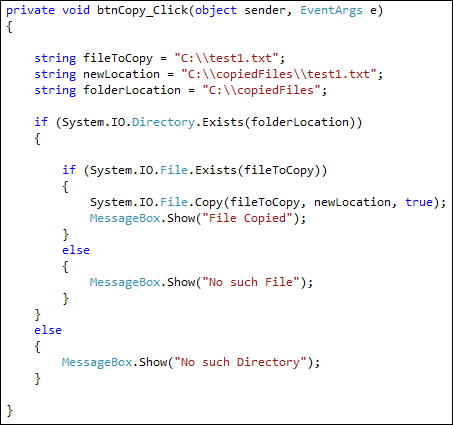You can copy a file quite easily. It's done with the File class of System.IO. Let's see how. First create a new folder on your C drive. Give it the name copiedFiles.
Add a new button to your form. Double click to get at the code, and set up the following files and directory paths:
string fileToCopy = "C:\\test1.txt";
string newLocation = "C:\\copiedFiles\\test1.txt";
string folderLocation = "C:\\copiedFiles";
string fileToCopy = "C:\\test1.txt";
string newLocation = "C:\\copiedFiles\\test1.txt";
string folderLocation = "C:\\copiedFiles";
So the file we want to copy is test1.txt and it is in the root folder of the C drive. We want to copy it to a new location. The folder (Directory) we want to copy it to is called copiedFiles. We added a Folder Location, because we want to check if this Directory exists.
To copy a file, you use the Copy method of the File class:
System.IO.File.Copy( fileToCopy, newLocation );
In between the round brackets of Copy, you need a file to copy and the new location of the file you're trying to copy.
When the error checking is done as well, our code looks like this:

The code checks to see if the Directory exists. If it does, then we check to see if the file exist. If all is OK, then we go ahead and copy the file.
Add the code to your own and try it out. When you click your button, you should see the "File Copied" message box appear. If you look in the copiedFiles folder that you created, you should see the test1.txt file there.
Move a File
To move a file to a new location, you would use the Move method of the File class:
System.IO.File.Move( fileToMove, fileLocation );
Everything else is the same: type a file to move between the round brackets of theMove method. Then, after a comma, add the new location.
Don't forget to add your error checking as well!
Delete a File
To delete a file from your computer, you can use the Delete method of the File class:
System.IO.File.Delete( file_path );
In between the round brackets of Delete, you need the name and path of the file you are trying to get rid of. Be very careful when trying this one out because it really does delete it. You won't find the file in the Recycle bin.














